By Julia Shepley
In January of 2018 I undertook a two-week residency at Penland School of Craft in North Carolina. Through my anticipatory experience for this and a previous residency at Zea Mays Printmaking in Florence MA, I learned that the process and activities of preparation can be one of the most important and fertile components of a residency experience. Considering how best to use the resources of a particular site provides an incentive to stretch my practices and research a new skill or methodology, as well as obtain or revisit a variety of materials with which to experiment.
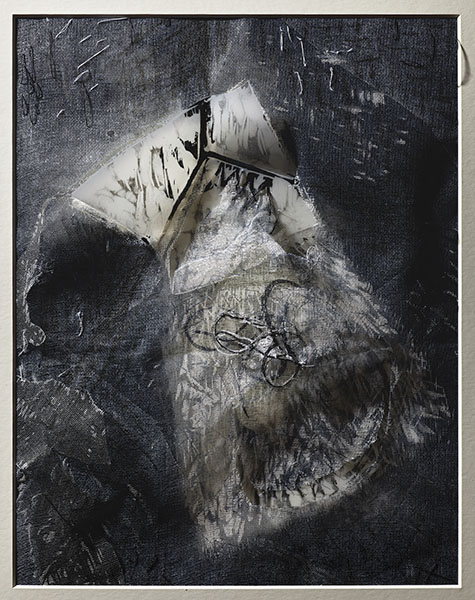
Muse, 2018, collaged woodblock prints on paper and scrim, thread, ink, 24 x 12 x 2″
As a sculptor and printmaker, I have always experimented with new processes and materials as a way to hover on the edge of unknown discoveries. I integrate printmaking into my drawing and sculpture practice by spending concentrated periods of time in a print shop or printmaking residency. The periodic experience of a collegial work environment with access to a range of equipment and methodologies is a nice balance to my solitary studio practice. My work in all media is a form of observational and exploratory drawing with parts pieced together in different configurations. Stitched marks and methods of joinery are integral to the image. Printmaking allows for experimental overlay of different drawn or photographed images as well as variations in perspective, scale and value of one drawing or image.
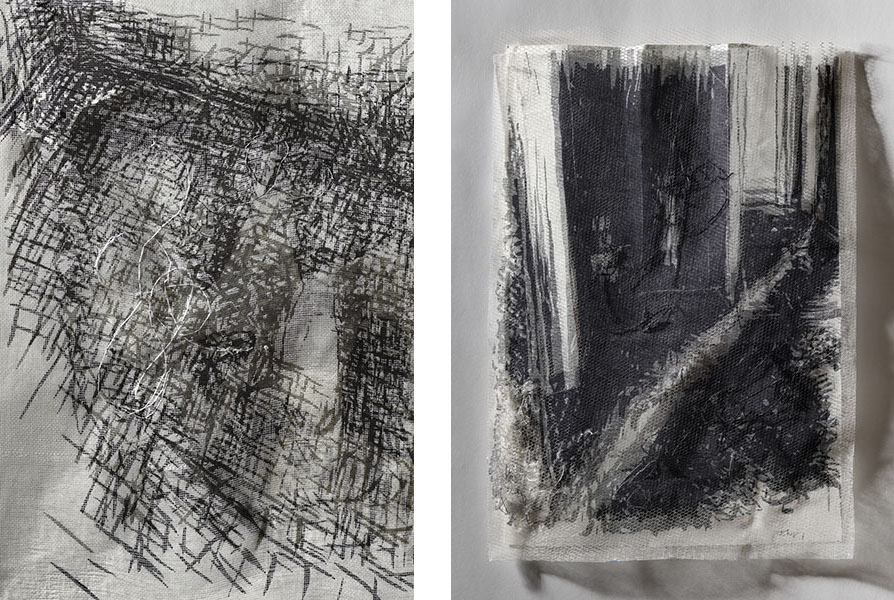
Left, Light Shadow Capture, 2018, collaged relief prints on paper, scrim, thread, 16 x 12 x 1″
Right, Sunbeam Through the House Forest, 2018, collaged relief prints
on paper and scrim, thread, 17 x 12 x 1″
For my residency at Penland, I originally applied for a combination of print and sculpture shops. This combination was not available, so I was offered placement in their Letterpress Studio working with Vandercook presses. I took the opportunity as a challenge to learn how to work with equipment and methodology unfamiliar to me. The self-inking feature of these presses presented an opportunity to print multiples of an image on different materials with greater ease. This would further facilitate my practice of experimentation with overlay, dimension, and integration of different types of mark making. The restrictions of the Vandercook promised to be freeing as well, as the scale had to be relatively small and the image graphic. To become familiar with use and cleaning of a Vandercook press beforehand, I was able to take a short tutorial with Eli Epstein of Union Press in Somerville. Eli was able to help me to think about attributes of Vandercook printing that might prove advantageous to my working process.
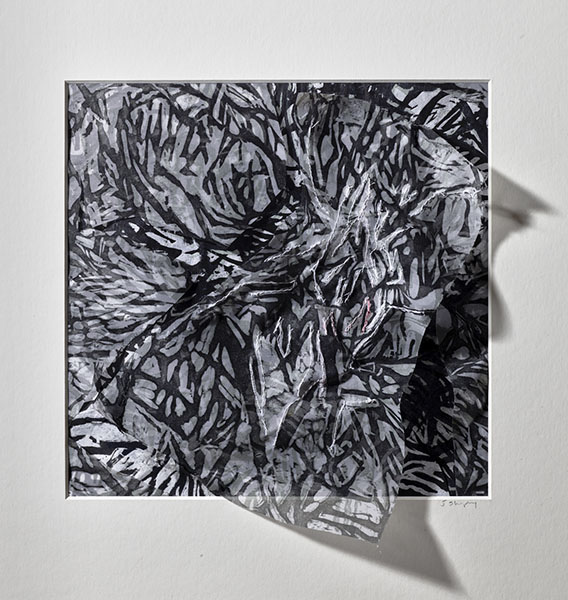
Repose, 2018, collaged woodblock prints on paper and translucent silk, thread, 12 x 12 x 2″
The letterpress/printmaking shop at Penland had an excellent set up for making photopolymer plates, so I also took the opportunity to learn the process for making photopolymer relief plates from scans of my brush ink drawings. Because the Vandercook is a relief printing press I needed to learn to prepare the photopolymer plates specifically for relief printing. I had already taken an excellent photopolymer etching workshop the year before with Nancy Diessner at Zea Mays, and she kindly agreed to give me a private lesson on the relief plate process at her studio.
Because of my long experience as a printmaker, I found I could use these one-on-one tutorials very efficiently and productively. Thanks to the pressure of a short deadline to get ready for the residency, I was able to discover the effectiveness and economy of individual tutorials for learning a very specific skill, and could look forward to the more general kind of cross pollination and comaraderie, as usually experienced in skill-building workshops with other artists, while at the residency.
In addition, I prepared several hand-carved woodblocks in order to be able to experiment with overlays of carved marks with brush or drawn marks in one image. I gathered different drawing media to experiment with on paper, to be used later for scanning different types of marks. Printed on film, these would be the positives for my photopolymer relief plates.
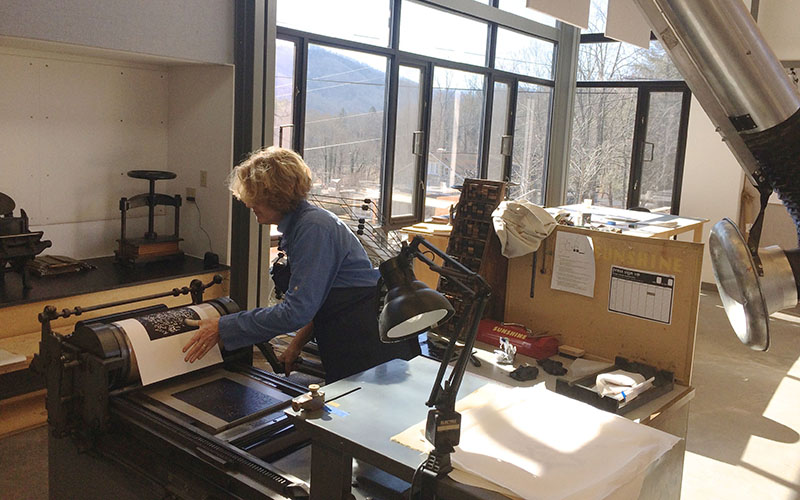
Julia Shepley printing at Penland School of Craft
As a result of my preparation, I was able to work intensively and fruitfully during the short two-week period of my residency. I appreciated the learning opportunities presented by “letterpress folks”, working around me in the open shop using different methodologies from my own printmaking practice, and enjoyed the anonymity of being an outlier. The printmaking studio was right next door in the same building with some shared equipment and would be my preferable choice if I were to go again because there is a wider range of equipment and types of artwork being done there. However, I was happy to have had the experience of preparing for and working in the Letterpress Studio as an impetus for experimenting with new methods. In addition, the view from the Letterpress Shop of the Smokey Mountains is breathtaking!
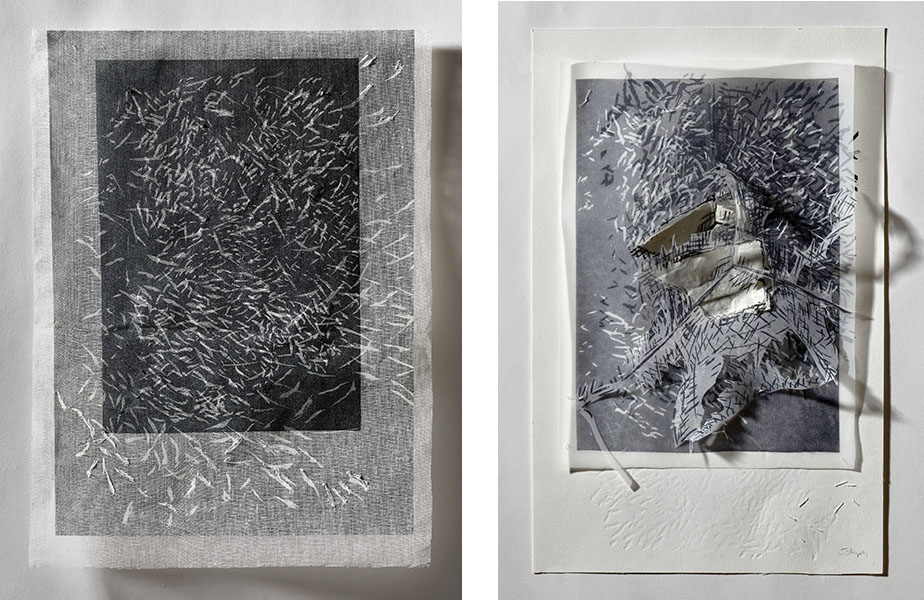
Left, Into the Shadows, 2018, collaged relief prints on paper and scrim, thread, 16 x12 x .5″
Right, Light Shadow Corner, 2018, collaged relief prints on paper
and translucent silk, thread, 16 x 10 x 1.5″
Shown are images of works done at Penland during the residency, with the following descriptions of two to exemplify my working methods. To make Lightshadow Corner I used three photopolymer relief plates made from positive and negative film versions of two scanned drawings. I printed multiple versions on different materials, then layered, folded, cut and tailored them together to create real and implied dimension. The work Into the Shadows is comprised of a photopolymer relief print on fabric over a woodcut print on mulberry paper. I created a space between the layers as well as stitched marks on the surface with stiffened knotted thread.